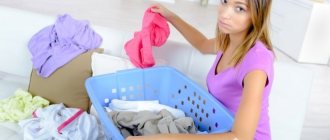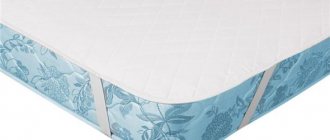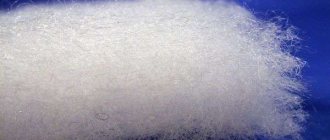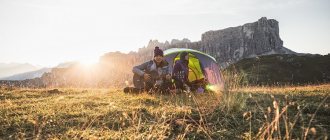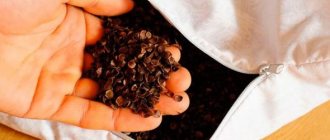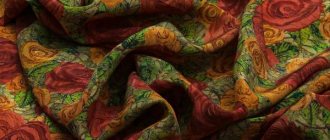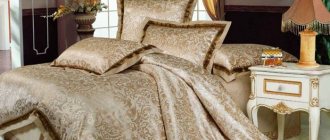Published: 06/05/2017,
Many manufacturers of bedding and mattresses claim that it is absolutely necessary to purchase an additional mattress cover for a mattress. Marketing gimmick or something really necessary? Let's figure it out.
Mattress covers became widely available relatively recently, 10-15 years ago. As the name implies, this product is intended to be placed on a mattress. Essentially, it is a cover that covers the surface of the mattress and can perform various functions. But is a mattress pad really necessary or can you get by with just a mattress and sheets? Does it really bring benefits or are its positive qualities overstated? To get answers to these questions, you need to understand the existing types of mattress covers and the qualities attributed to them.
Why do you need a mattress pad?
A mattress cover performs several functions, the main one being to protect the mattress from moisture, dirt and wear. Often replacing a mattress with a new one is expensive and troublesome; cleaning and drying is labor-intensive, time-consuming and not always effective; in addition, after some liquids there is an odor that is difficult to get rid of. A waterproof mattress cover will protect the mattress from spilled coffee, from leaking liters of sweat in some diseases, and from shedding sheets. Even those who are always healthy and impeccably neat will benefit from the opportunity to wash a mattress cover: the bed accumulates a lot of dust, and if there is a cover, the dust settles on it, almost never getting onto the mattress. When washing, dust is washed away from the mattress cover, thus maintaining fresher, cleaner air in the bedroom.
This item has other useful properties:
- The surface of some mattresses is cold to the touch; a thin sheet does not insulate against the cold. The mattress cover creates a more comfortable microclimate;
- Some models of mattress covers, due to their increased thickness, help regulate the rigidity of the sleeping area and level out unevenness of the mattress;
- There are mattress covers with antibacterial properties;
- The rough or fluffy surface of the cover prevents problems such as sheets slipping on the mattress.
How does a mattress protector protect your mattress?
Selection tips:
- buy products from certified manufacturers. They are definitely made from safe materials, do not have unpleasant fragrances and do not emit toxic substances that can cause allergies. If in doubt, it is better to ask the seller for a quality certificate;
- We recommend choosing models with a quilted surface: these fit better on the mattress and have a longer service life;
- the choice in favor of anatomical models of mattress covers should be made only on the recommendation of a specialist. These products are not suitable for everyone;
- Before purchasing, you can read reviews about the product you like. This will allow you to find out about the presence of disadvantages, which at first glance may seem insignificant, but during operation they will make themselves felt;
- The more internal layers, the more expensive the model is. Latex, dense elastic foam, polyester fiber, coconut coir and other materials can be used as filler.
Do you need a mattress protector for an orthopedic mattress?
Most often, mattresses are covered with smooth synthetic fabric, sometimes so slippery that only a sheet with an elastic band can stay on the bed. Regular sheets tend to bunch up, no matter how hard they are pushed against the mattress. The mattress protector helps the sheet stay in place.
In addition, orthopedic mattresses are thick, so if liquid gets in, they are not easy to dry. Repeated treatment of the contaminated surface with a brush and cleaning agents spoils the appearance of the mattress. Having bought an expensive high-quality mattress, without proper protection, in a couple of years you can end up with a worn-out, unattractive bedding. Therefore, purchasing a moisture-resistant mattress topper will be a good investment in extending the life of your mattress.
The cover also has this interesting ability: if a husband and wife prefer mattresses of different hardness, you can put two single mattresses on a double bed, selected taking into account the wishes of each spouse, and connect them with a mattress pad.
What it is
Mattress covers are covers - protection for mattresses. They are used to protect against contamination and premature wear of the main product. When combined with other bedding, they create comfortable conditions for rest.
Experts definitely recommend using it if the mattress is foam rubber, latex, or contains synthetic components. They cannot provide the moisture exchange necessary for the body.
You can also ask the seller what a mattress pad is when choosing a mattress. The consultation will help you choose an accessory.
Main functions of the case:
- prevents dust accumulation;
- protects against premature wear;
- normalizes hygiene during sleep, normalizing the microclimate in bed;
- adds hardness or softness to the base.
The accessory must match the size of the base, cover it completely, not bunch up or slip off. When choosing, it is recommended to pay attention to the possibility of removing the cover.
Types of mattress covers
Mattress covers can be universal. Inexpensive products usually have a small number of functions. There are mattress covers that are comparable in price to an economy-segment mattress. Based on their main functionality, the following types of namats are distinguished:
- protective;
- orthopedic;
- corrective;
- waterproof;
- anti-decubitus;
- insulated;
- antibacterial;
- seasonal and many others.
Most cases cope with 2-3 tasks at once. The most common are the first 3 types from the list.
The mattress cover must match the size of the mattress. If the mattress has non-standard sizes, you can buy a slightly larger cover, and after trying it on, decide whether you need to adjust the size. Most likely, a thin mattress cover will only need to be folded, but a thick hard cover may need to be hemmed on one side. You should avoid buying a cover that is too small - it cannot be pulled over the mattress. On sale you can find mattress covers for beds 80, 90 cm wide, and from 100 to 200 cm wide in increments of 20 cm. The standard length is 190 and 200 cm. Covers of other sizes, as well as round and oval, are less common.
Corrective mattress covers
As the name suggests, a mattress topper can change the performance properties of a mattress. Of course, it will not change the mattress itself, but the person lying down will feel a significant difference. Ultimately, what is more important to the user is the final characteristics of the sleeping place, and not what properties will depend on the mattress and what properties will depend on the coating. The corrective mattress cover copes with the following tasks:
- makes the sleeping place softer or harder;
- levels the surface of the mattress;
- smoothes out all irregularities - dents, protruding springs;
- Helps achieve a comfortable temperature.
Orthopedic, anti-decubitus, insulated and seasonal mattress covers are classified as corrective.
Protective mattress covers
Protective mattress covers include those that protect the mattress from external influences: dirt, dust, liquids, and minor damage. Depending on their capabilities, they are divided into the following types:
- classic. As a rule, the cheapest. Protect the mattress from dirt and minor damage, such as puffs from cat claws;
- waterproof. Protects against spilled water and body fluids;
- hypoallergenic. Made from materials that do not cause allergies. Any fabric is treated with various substances - bleaches, dyes, impregnations. For this type of cover, the material undergoes minimal processing with the safest substances.
- antibacterial. Prevents the development of microorganisms, fungi, mold.
This type of mattress cover is the most popular.
Orthopedic (toppers) mattress covers
Mattress covers of this type (toppers) are quite thick, from 2 to 8 cm. Their properties depend on the material from which they are made. Felt, latex struttofiber and holofiber soften the sleeping area. Coconut and bamboo fiber, palm coir, and horsehair make the sleeping area more rigid. There are also various natural and synthetic fillers of medium hardness. Each of these materials has additional properties: protective, antibacterial, etc.
Important! Mattress covers with coconut fiber should not be bent, as this can ruin them forever.
The memory foam filler is interesting: it preserves the contours of the body of the person sleeping on it, this provides special comfort and coziness.
Corrective
This type of mattress cover adjusts the performance characteristics of the mattress, in particular:
- smoothes its surface;
- smoothes out deformed areas (pressed areas, protruding springs);
- can soften a surface that is too hard or, conversely, make a too soft bed harder;
- regulates temperature. A mattress pad, of course, cannot influence the temperature of the mattress, but it can influence our sensations. Depending on your needs, a mattress cover can provide warmth or, conversely, provide coolness.
Caring for your mattress cover
Mattress covers are especially valuable because they are easy to care for. They are easy to remove and put on again after necessary measures. In order for the mattress cover to serve for a long time and constantly delight you with freshness, it must be washed and ventilated periodically. Sometimes it’s enough just to shake off the dust and debris. Some types of covers cannot be washed. If the symbols on the label prohibit washing, you should take the product to dry cleaning as needed.
It is prohibited to iron mattress covers: for medium-thick covers, the filling may lose volume; for moisture-resistant ones, the lamination of the fabric, which ensures waterproofness, will deteriorate under the influence of high temperatures. It is recommended to study the information on the product label or packaging to learn the nuances of caring for the desired mattress cover model.
Advice: if the rules for caring for the cover are lost, you can focus on a temperature of 40 degrees. Most mattress toppers cannot be washed in hotter water.
Those types of mattress covers, the care of which involves washing, dry quickly enough so that mold does not have time to grow in them. Before washing, you need to make sure that the detergent is suitable for the type of fabric of the product.
Mattresses Furniture
Popular manufacturers
There is a rating of companies producing mattress covers that have proven themselves well. Let's look at the most popular:
- Askona - the Swedish factory occupies a leading position. The products are of high quality, but the prices for mattress covers are not affordable for everyone.
- Comfort Line - special attention is paid to orthopedic products, prices for every pocket.
- Ormatek is the leader in Russian production; it can be manufactured to individual sizes.
- Lonax (Lonax) - the company has strict quality control, but a small guarantee.
You can also find products from the following brands on sale: Alvitek, Perina, Ecotex (Ekotex), Perrino, Ikea (Ikea), well-established Ivanovo textiles and various manufacturers from Ivanovo, Promtex-Orient, Togas, Artpostel and others.
Is there a guarantee
Typically the warranty is 1-2 years. The exact period indicated on each product depends on its composition, characteristics and manufacturer. But warranty service is valid only if the buyer strictly complies with all recommendations for use and care. If the manufacturer determines violations, the buyer will not be able to replace the product.
When applying, there must be a label that serves as proof of purchase. The warranty does not apply to:
- scratches, cuts, snags;
- attempts to independently eliminate defects;
- organic pollution;
- damage that occurred during transportation;
- natural wear and tear.
Before determining why you need a mattress topper, you should consider the pros and cons of each type. Multilayer accessories are characterized by natural shrinkage.
This occurs under the pressure of a person’s weight and is the norm. Warranty service is not valid in such cases. To replace defective goods, a special examination is initially carried out.
Fabrics
Protective mattress covers, orthopedic or moisture-resistant, have covers that are made from a variety of materials. Natural or synthetic, they must comply with all sanitary standards, be completely safe for health, and not emit hazardous chemical compounds when burned. When making a cover, the following are used from natural materials:
- cotton is a dense but not stuffy material that will be comfortable at any time of the year and will retain its good appearance for a long time;
- calico is a cheaper cotton fabric that has a shorter service life and is more suitable for children's models;
- bamboo is a common fabric for mattress covers, which has antibacterial properties and is comfortable at any time of the year;
- silk - used for expensive products for use in the summer, as the material cools well in the heat.
There is a combined covering material - jacquard. This is a practical and comfortable option for any time of year.
Synthetic fabric for mattress covers comes in the following types:
- polyester is a cheap, not very comfortable material that turns out to be stuffy in the summer;
- polycotton;
- microfiber is the best of artificial materials, which will not be either hot or cold.
Children should choose mattress covers and covers for mattresses only with natural coating. This is a guarantee that allergies and compress effects will not occur.
The material, both natural and synthetic, must have documentation confirming the quality of the product. Without it, you should not buy a product, as it may be harmful to health and sometimes pose a danger to the sleeper. This is especially true for products for permanent use.
Materials
Types of fabrics used for covering:
- cotton;
- polycotton;
- merino wool;
- satin;
- knitwear;
- mahra;
- microfiber;
- velours;
- calico;
- percale.
Fillers:
- padding polyester;
- latex;
- bamboo;
- swansdown;
- cotton;
- sheep's wool;
- merino;
- goose down
For orthopedic products, latex, coconut coir, and struttofiber are used.
Basically, protection for mattresses is classified as follows.
Synthetic. It is durable, practical, able to retain its shape, and prevents the development of pathogenic microorganisms.
Natural. It is made of environmental materials. Among the disadvantages is the risk of developing allergies in the owner.
Combined. It is presented in a combination of natural and synthetic material.

